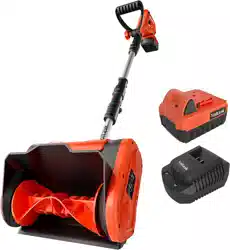Loading ...
Loading ...
Loading ...

Proper Care of Battery and Charger
BATTERY AND CHARGER SAFETY INSTRUCTIONS 10
Off-Season Storage of Battery and Charger
SS-20C
Proper Dispose of Battery and Charger
Battery Pack Recycling
1.
2.
3.
4.
To reduce the risk of injury and damage, never immerse your battery pack or charger in liquid or allow any
liquid to flow inside these components.
Clean out dust and debris from charger vents and electrical contacts by blowing with compressed air.
Use only mild soap on a damp cloth to clean the battery pack and charger, keeping away from all electrical
contacts. Certain cleaning agents and solvents are harmful to plastics and other insulated parts. Some of
these harmful substances include gasoline, turpentine, lacquer thinner, paint thinner, chlorinated cleaning
solvents, ammonia, and household detergents containing ammonia. Never use flammable or combustible
solvents around battery packs, battery chargers, or tools.
The lithium-ion battery charger has no serviceable parts.
1.
2.
3.
4.
5.
6.
Batteries vary according to device. Consult your manual for specific information.
Install only new batteries of the same type in your product (where applicable).
Failure to insert batteries in the correct polarity, as indicated in the battery compartment or manual, may
shorten the life of the batteries or cause batteries to leak.
Do not mix old and new batteries.
Do not dispose of batteries in a fire or incinerator.
Batteries should be recycled or disposed of as per state and local guidelines.
To preserve our natural resources, please recycle or dispose of batteries properly. The batteries charged
by this charger may contain chemicals and metals that are harmful to the environment. Never dispose of
rechargeable batteries in your normal household garbage or in landfill sites because to do so will
unnecessarily pollute the environment.
a.
b.
Do not expose your battery pack or charger to water or rain, or otherwise allow these items to get wet.
Wetness could permanently damage the charger and the battery pack. Do not use oil or solvents to clean
or lubricate your battery pack as these substances can cause the plastic casing to become brittle and
crack, posing a serious risk of injury.
Store the battery pack and charger at room temperature away from moisture. Do not store these items in
damp locations, where corrosion of terminals may occur. As with other battery pack types, permanent
capacity loss can result if the pack is stored for long periods at high temperatures (above 105°F/40.5 ℃ ).
WARNING! To reduce the risk of injury, always unplug the charger and remove the battery pack
from the charger before performing any maintenance task.
CAUTION! Even discharged battery packs contain some energy. Before disposing of them, cover
the terminals with electrical tape to prevent shorting, which could cause a fire or explosion.
WARNING! To reduce the risk of injury or explosion, never burn or incinerate a battery
pack—even if it is damaged, dead, or completely discharged. When batteries burn, they emit
toxic fumes and materials into the atmosphere.
Always dispose of your battery pack according to federal, state, and local regulations. Search online and/or
contact a recycling agency in your area to find a suitable location for recycling the battery pack.
Loading ...
Loading ...
Loading ...
